Article
Photographing Woodpeckers
In Britain we have 3 woodpeckers, two
mainly black and white and one larger and mainly green. They are known as
the great spotted, the lesser spotted and green woodpeckers.
Of these the great spotted is the most
photographed as it regularly visits garden feeders, liking peanuts and fat
balls. The green woodpecker also visits gardens regularly eating mostly ants
in lawns, but while the great spotted woodpecker will tolerate people at a
distance, or even in some cases you may be able to get near to them, the
green woodpecker will be off at the first site of anyone, even if its spots
you looking at it out of a window.
The Green Woodpecker
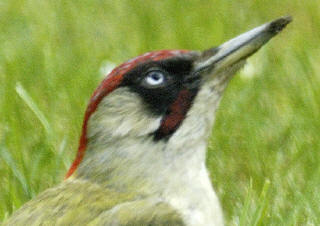 |
The most many see of the green woodpecker
is what appears to be a large yellow bird that travels very fast, and gives
out a shriek. When on the ground their olive green backs give them a
lot of camouflage and from a way off you won't even spot them.
They visits lawns and fields with shortish
grass looking for ants. They peck a hole in the ground at speed and
use a long sticky tongue to catch the ants. Having pecked rapidly at the
ground a number of times it sits back looks around, looks up and around
looking out from predators, and in particular birds of prey.
  |
To photograph it you need to have a good
hiding place with no lights behind you, often indoors and to only move when
it has its head in the ground. If it spots you, its off, its difficult to
get them accustomed to you taking photographs in the way you can with many
birds as its does not stay long enough to allow you to make any progress.
Having said this I have several thousand photos of green woodpeckers,
including some of the adult feeding the young and others of the adult and
young feeding together, all of these I took from in a house through windows.
At least one young one I did get eventually to tolerate me photographing it and on one
occasion one even came up closer to see what I was doing.
Although they have very long tongues you
don't normally catch them in photographs, I have only managed to catch one
with its tongue out on two occasions, one far clearer than the other.
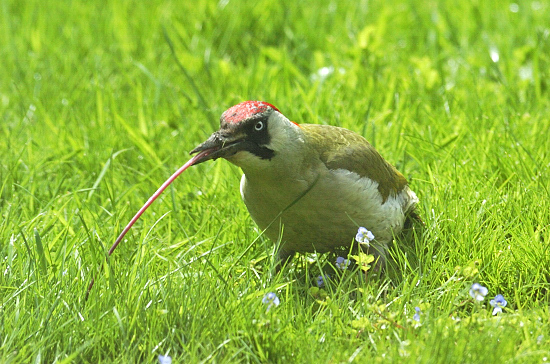 
| The males and females are very similar in
appearance, but the male has a red marking in the black strip coming from
the mouth. This can be difficult to see. The young are distinctly different
with a motley pattern. As they don't visits garden feeders or eat
any food that you can put out for them, the only thing that you can do to
encourage them to visit your lawn is not to kill all the ants nests. If you
are looking for another location that may have green woodpeckers visiting,
look for a location that has a lot of deciduous, broad leaf trees nearby and
a place where there are ants nests in short grass. If you can, find a natural
hiding place or use a hide, and have the patience you may be lucky. While a
car is enough of a hide to look at many birds, the green woodpecker will
take flight or rarely go near cars unless its been stood in the same place
with no sign of people for some time.
When young are first seen they are on tress
or bushes following and watching the adults, and the adults then go back to
feed them. A little later the young come out of the tress near to the adult
and follow them around, however often the adult will take flight and the
young bird will just stay very still on the ground, waiting for the adult to
return. If you are looking, on returning the adult will feed the young bird,
and you may gat a chance to photograph them together. A little later the
young also learns to feed on ants and you can see then the adult and young
feeding together.
 |
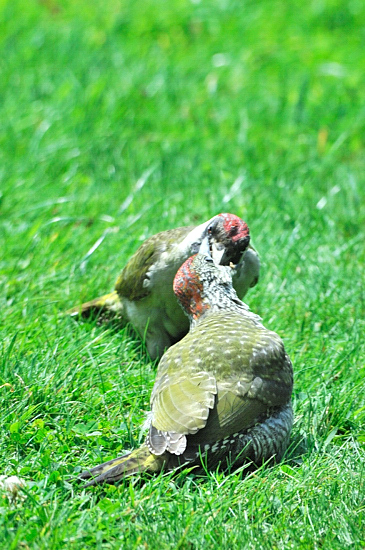 |
See, species' page on the
Green
Woodpecker
 and the
Green Woodpecker Gallery. and the
Green Woodpecker Gallery.
Lesser Spotted Woodpecker
This is a smaller woodpecker that is far
more rare and seldom photographed, its spends most if its time in the top of
trees and rarely, if ever, visits gardens. It is much smaller than the great
spotted and has white stripes instead of a large white spot on the top
part of its wings.
Those who have managed to photograph it
have either done so at a distance, finding it by listening for its
hammering in the early spring, before there are too many leaves on trees to
see it, or have put hides near to places where it will come down for water,
so for example where there is a piece of woodland that they are known to be
in and a single small pond in the woodland. Although I have seen lesser
spotted woodpeckers on a few occasions I have not so far photographed one.
See, species' page on the
Lesser Spotted Woodpecker.

|
Great spotted woodpecker
The most common and most photographed of the
UK woodpeckers. It will tolerate people once it becomes used to you, and
will even feed its young close to you knowing you are present. It is
particularly keen on peanuts and fat feeders, so is a frequent visitor to
many country bird tables and even some in towns and cities.
They usually first fly to a tree nearby where
they can check the area is safe before coming to the feeder. Where there are
a number, usually as one flies in the one already present will fly out, so
except for a parents and a young it is rare to see more than one at a time
on feeders. When flying from the nearby tree to the feeders they fly looking
forward, and I have a couple of photographs of them flying directly
towards the camera. However I don't think their eye sight in flight is all
that good as on one occasion one landed on my arm while I was tying up a
peanut feeder so that squirrels could not remove it. I was however wearing
a green shirt on this occasion. It was as surprised as I was to find itself
inches from my face. The adult male
has a red back to its neck while the adult female does not. The young has a
red cap. In most cases where I have seen one of the young being fed at or
near a bird feeder, its been the male adult that has been doing it.
When I had a couple of feeding
stations and Greet Spotted Woodpeckers were coming in all the time, I found
I could tell one from another, in some cases by size, in other cases by
shape, some being plumper than others and on occasions as some had extra
feathers around their chin areas. Similarly there are differences between
younger ones as well. |
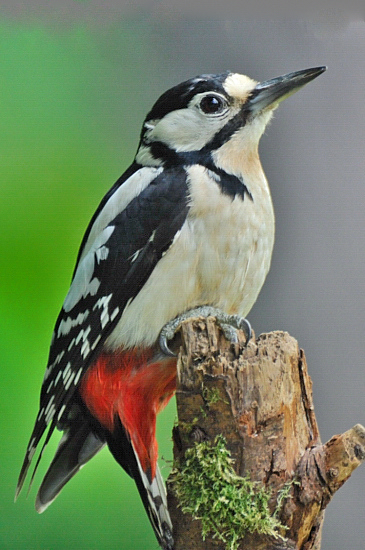
 Female Great Spotted Woodpecker
Female Great Spotted Woodpecker |
In many books
it says that they do not eat ants or feed on the ground but I have seen and
photographed them doing this, although its far less common than with the
green woodpecker.
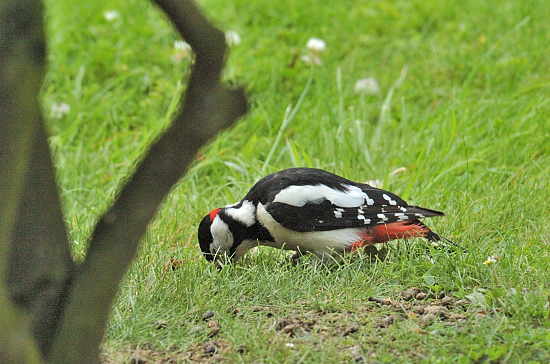
 Male Great Spotted Woodpecker Feeding on
the Ground
Male Great Spotted Woodpecker Feeding on
the Ground
| When feeding they
are always stopping to check for predators, especially birds of prey, often
working their way around feeders or branches looking to the sky. Although
they have a powerful peck and few other birds even far larger ones will
challenge them. I have seen one taken by a bird of prey, and know of
another case where it fought back and made so much noise that it
caused a lot of interest, bringing people out to see what was happening and
causing the bird of prey to drop it and fly away.
The easiest way to photograph them is near or
at feeders. Quite a few of my favourite photos of Great Spotted Woodpeckers
are with them on a small wooden post, that I tied to the feeding station,
giving them something to land on near the feeders. While initially on seeing
you they will fly away, after a short time they become accustomed to
you and you will find that you can get near to an open window, being in full
view and moving about, or even stand outside near the feeders, as long as you stand still. Like many of the other garden and game birds that
became used to attending our feeding stations, I found they were happier to
come near me when I was in normal clothes, and were in open display, either
inside or outside, than when I was in either camouflage or partially hidden.
Male Feeding Young
Woodpecker
 |
 |
See, species' page on the
Great Spotted Woodpecker
 and the
Great Spotted Woodpecker. and the
Great Spotted Woodpecker.

|